Understanding Needs and Potentials for Gender-Balanced Empowerment and Leadership in Climate Change Adaptation and Mitigation in Africa
Abstract
:1. Introduction: Climate Change–Gender Interconnections
2. Climate Change-Gender Interconnections in Leadership/Empowerment
3. Gender Leadership/Empowerment in Climate Change in the African Context
4. Materials and Methods
4.1. Bibliometric Analysis
4.2. Online Questionnaire
5. Results and Discussion
5.1. Bibliometric Analysis
5.2. Online Questionnaire
5.2.1. Respondents’ Characteristics
5.2.2. Women’s Leadership/Empowerment in Climate Change
5.3. Final Remarks
6. Conclusions
Author Contributions
Funding
Institutional Review Board Statement
Informed Consent Statement
Data Availability Statement
Conflicts of Interest
Appendix A
| Abbreviation | Name |
|---|---|
| CTCN Advisory Board | Climate Technology Centre and Network Advisory Board |
| CC Facilitative Branch | Compliance Committee Facilitative Branch |
| CC Enforcement Branch | Compliance Committee Enforcement Branch |
| CGE | Consultative Group of Experts |
| CDM Executive Board | Clean Development Mechanism Executive Board |
| GCF Board | Green Climate Fund Board |
| JISC | Joint Implementation Supervisory Committee |
| LEG | Least Developed Countries Expert Group |
| PCCB | Paris Committee on Capacity-building |
| SCF | Standing Committee on Finance |
| TEC | Technology Executive Committee |
| FWG | Facilitative Working Group |
| KCI | Katowice Committee of Experts on the Impacts of the Implementation of Response Measures |
| PAICC | Paris Agreement Implementation and Compliance Committee |
| COP | Conference of the Parties |
References
- UN Secretary-General. Overview of United Nations Activities in Relation to Climate Change: Report of the Secretary-General (A/62/644); United Nations: New York, NY, USA, 2008. [Google Scholar]
- UNFCCC. Gender and climate change. Draft conclusions proposed by the Chair. Recommendation of the Subsidiary Body for Implementation. In Draft Decision-/CP.23 Establishment of a Gender Action Plan; FCCC/SBI/2017/L.29; United Nations Framework Convention on Climate Change; UNFCCC: Bonn, Germany, 2017. [Google Scholar]
- Björnberg, K.E.; Hansson, S.O. Gendering local climate adaptation. Local Environ. 2013, 18, 217–232. [Google Scholar] [CrossRef]
- Rohr, U. Gender, climate change and adaptation. Introduction to the Gender Dimensions. In Background Paper for the Both ENDS Briefing Paper “Adapting to Climate Change: How Local Experiences Can Shape the Debate”; Both ENDS: Amsterdam, The Netherlands, 2007. [Google Scholar]
- IPCC. Summary for policymakers. In Climate Change 2014: Impacts, Adaptation, and Vulnerability. Part A: Global and Sectoral Aspects. Contribution of Working Group II to the Fifth Assessment Report of the Intergovernmental Panel on Climate Change; Field, C.B., Barros, V.R., Dokken, D.J., Mach, K.J., Mastrandrea, M.D., Bilir, T.E., Chatterjee, M., Ebi, K.L., Estrada, Y.O., Genova, R.C., et al., Eds.; Cambridge University Press: Cambridge, UK; New York, NY, USA, 2014; pp. 1–32. [Google Scholar]
- Mensah, M.; Vlek, P.L.G.; Fosu-Mensah, B.Y. Gender and climate change linkages in the semi-arid region of Ghana. GeoJournal 2022, 87, 363–376. [Google Scholar] [CrossRef]
- Bunce, A.; Ford, J. How is adaptation, resilience, and vulnerability research engaging with gender? Environ. Res. Lett. 2015, 10, 123003. [Google Scholar] [CrossRef] [Green Version]
- von Lander Svendsen, N.; Weber, K.; Factor, G.; Winther Engelsbak, L.; Fischer-Bogason, R. How Climate Policies Impact Gender and Vice Versa in the Nordic Countries; Nordic Council of Ministers: Copenhagen, Denmark, 2022. [Google Scholar]
- Pearse, R. Gender and climate change. WIREs Clim. Chang. 2016, 8, e451. [Google Scholar] [CrossRef]
- Brody, A.; Demetriades, J.; Esplen, E. Gender and Climate Change: Mapping the Linkages a Scoping Study on Knowledge and Gaps; BRIDGE, Institute of Development Studies (IDS), University of Sussex: Brighton, UK, 2008. [Google Scholar]
- Sellers, S. Gender and Climate Change: A Closer Look at Existing Evidence; Global Gender and Climate Alliance (GGCA): Bali, Indonesia, 2016. [Google Scholar]
- Lambrou, Y.; Piana, G. Gender: The Missing Component of the Response to Climate Change; Food and Agriculture Organization of the United Nations: Rome, Italy, 2006. [Google Scholar]
- Alston, M. Women and adaptation. Wiley Interdiscip. Rev. Clim. Chang. 2013, 4, 351–358. [Google Scholar] [CrossRef]
- Reggers, A. Climate Change Is Not Gender Neutral: Gender Inequality, Rights and Vulnerabilities in Bangladesh. In Confronting Climate Change in Bangladesh. The Anthropocene: Politik—Economics—Society—Science; Huq, S., Chow, J., Fenton, A., Stott, C., Taub, J., Wright, H., Eds.; Springer: Cham, Switzerland, 2019; Volume 28. [Google Scholar] [CrossRef]
- FAO; ARC. Women’s Leadership and Gender Equality in Climate Action and Disaster Risk Reduction in Africa—A Call for Action; FAO: Rome, Italy, 2021. [Google Scholar] [CrossRef]
- Eskenazi, B.; Etzel, R.A.; Sripada, K.; Cairns, M.R.; Hertz-Picciotto, I.; Kordas, K.; Machado Torres, J.P.; Mielke, H.W.; Oulhote, Y.; Quirós-Alcalá, L.; et al. The International Society for Children’s Health and the Environment Commits to Reduce Its Carbon Footprint to Safeguard Children’s Health. Environ. Health Perspect. 2020, 128, 014501. [Google Scholar] [CrossRef] [Green Version]
- Khandekar, N.; Gorti, G.; Bhadwal, S.; Rijhwani, V. Perceptions of climate shocks and gender vulnerabilities in the Upper Ganga Basin. Environ. Dev. 2019, 31, 97–109. [Google Scholar] [CrossRef]
- Habtezion, S. Overview of Linkages between Gender and Climate Change, Policy Brief; United Nations Development Programme: New York, NY, USA, 2013. [Google Scholar]
- Yadav, S.S.; Lal, R. Vulnerability of women to climate change in arid and semi-arid regions: The case of India and South Asia. J. Arid. Environ. 2018, 149, 4–17. [Google Scholar] [CrossRef]
- Kabir, R.; Khan, H.T.; Ball, E.; Caldwell, K. Climate change impact: The experience of the coastal areas of Bangladesh affected by Cyclones Sidr and Aila. J. Environ. Public Health 2016, 2016, 9654753. [Google Scholar] [CrossRef] [Green Version]
- Nhamo, G. Addressing women in climate change policies: A focus on selected east and southern African countries. Agenda 2014, 28, 156–167. [Google Scholar] [CrossRef]
- Least Developed Countries Expert Group. Strengthening Gender Considerations in Adaptation Planning and Implementation in the Least Developed Countries; United Nations Framework Convention on Climate Change (UNFCCC): Bonn, Germany, 2015. [Google Scholar]
- Ford, J.D.; Berrang-Ford, L.; Bunce, A.; McKay, C.; Irwin, M.; Pearce, T. The status of climate change adaptation in Africa and Asia. Reg. Environ. Chang. 2015, 15, 801–814. [Google Scholar] [CrossRef]
- Habtezion, S. Training Module 5 Gender and Climate Finance; United Nations Development Programme: New York, NY, USA, 2016. [Google Scholar]
- Davis, A.; Roper, L.; Miniszewski, U. Climate Justice and Women’s Rights: A Guide to Supporting Grassroots Women’s Action; Global Greengrants Fund (GGF): Boulder, CO, USA; International Network of Women’s Funds (INWF): México City, Mexico; Alliance of Funds: São Paulo, Brazil, 2015. [Google Scholar]
- Glemarec, Y.; Qayum, S.; Olshanskaya, M. Leveraging co-benefits between gender equality and climate action for sustainable development. In Mainstreaming Gender Considerations in Climate Change Projects; UN Women: New York, NY, USA, 2016. [Google Scholar]
- Dankelman, I. Introduction: Exploring Gender, Environment and Climate change. In Gender and Climate Change: An Introduction; Dankelman, I., Ed.; Routledge: London, UK, 2010. [Google Scholar]
- Glazebrook, T. Women and Climate Change: A Case-Study from Northeast Ghana. Hypatia 2011, 26, 762–782. Available online: http://www.jstor.org/stable/41328879 (accessed on 17 February 2022). [CrossRef]
- Osman-Elasha, B. Women in the Shadow of Climate Change; UN Chronicle; United Nations: New York, NY, USA, 2013; Available online: https://www.un.org/en/chronicle/article/womenin-shadow-climate-change (accessed on 17 February 2022).
- Aguilar, L.; Granat, M.; Owren, C. Roots for the Future: The Landscape and Way Forward on Gender and Climate Change; IUCN & GGCA: Washington, DC, USA, 2015. [Google Scholar]
- IUCN. Gender and climate change. In Strengthening Climate Action by Promoting Gender Equality; Issues Brief; International Union for Conservation of Nature: Gland, Switzerland, 2015. [Google Scholar]
- Cook, N.J.; Grillos, T.; Andersson, K.P. Gender quotas increase the equality and effectiveness of climate policy interventions. Nat. Clim. Chang. 2019, 9, 330–334. [Google Scholar] [CrossRef]
- Andrijevic, M.; Cuaresma, J.C.; Lissner, T.; Thomas, A.; Schleussner, C.-F. Overcoming gender inequality for climate resilient development. Nat. Commun. 2020, 11, 6261. [Google Scholar] [CrossRef] [PubMed]
- FAO. The state of food and agriculture. In Women in Agriculture; Closing the Gender Gap for Development; Food and Agriculture Organization of the United Nations: Rome, Italy, 2011. [Google Scholar]
- Carvajal-Escobar, Y.; Quintero-Angel, M.; Garcia-Vargas, M. Women’s Role in Adapting to Climate Change and Variability. Adv. Geo Sci. Issue 2008, 14, 277–280. [Google Scholar] [CrossRef] [Green Version]
- FAO; CARE. Good Practices for Integrating Gender Equality and Women’s Empowerment in Climate-Smart Agriculture Programmes; FAO: Rome, Italy; CARE: Atlanta, GA, USA, 2019. [Google Scholar]
- Dar, M.H.; Waza, S.A.; Nayak, S.; Chakravorty, R.; Zaidi, N.W.; Hossain, M. Gender focused training and knowledge enhances the adoption of climate resilient seeds. Technol. Soc. 2020, 63, 101388. [Google Scholar] [CrossRef] [PubMed]
- Oyawole, F.P.; Shittu, A.; Kehinde, M.; Ogunnaike, G.; Akinjobi, L.T. Women empowerment and adoption of climate-smart agricultural practices in Nigeria. Afr. J. Econ. Manag. Stud. 2020, 12, 105–119. [Google Scholar] [CrossRef]
- Glazebrook, T.; Noll, S.; Opoku, E. Gender Matters: Climate Change, Gender Bias, and Women’s Farming in the Global South and North. Agriculture 2020, 10, 267. [Google Scholar] [CrossRef]
- Parker, C.F.; Karlsson, C.; Hjerpe, M. Climate change leaders and followers: Leadership recognition and selection in the UNFCCC negotiations. Int. Relat. 2015, 29, 434–454. [Google Scholar] [CrossRef]
- United Nations. Paris Agreement; United Nations: New York, NY, USA, 2015. [Google Scholar]
- FAO. FAO Policy on Gender Equality 2020–2030; Food and Agriculture Organization of the United Nations: Rome, Italy, 2020. [Google Scholar]
- UNDP. Gender Mainstreaming: A Key Driver of Development in Environment and Energy; United Nations Development Programme: New York, NY, USA, 2007. [Google Scholar]
- Chen, Y.Z.; Tanaka, H. Women’s Empowerment. In Encyclopedia of Quality of Life and Well-Being Research; Michalos, A.C., Ed.; Springer: Dordrecht, The Netherlands, 2014. [Google Scholar] [CrossRef]
- Mekonnen, Z. Intra-household gender disparity: Effects on climate change adaptation in Arsi Negele district, Ethiopia. Heliyon 2022, 8, e08908. [Google Scholar] [CrossRef]
- Habib, N.; Alauddin, M.; Cramb, R. What defines livelihood vulnerability to climate change in rain-fed, rural regions? A qualitative study of men’s and women’s vulnerability to climate change in Pakistan’s Punjab. Cogent Soc. Sci. 2022, 8, 2054152. [Google Scholar] [CrossRef]
- Neumayer, E.; Plümper, T. The Gendered Nature of Natural Disasters: The Impact of Catastrophic Events on the Gender Gap in Life Expectancy, 1981–2002. Ann. Assoc. Am. Geogr. 2007, 97, 551–566. [Google Scholar] [CrossRef] [Green Version]
- Soroptimist International of the Americas. White Paper: Reaching Out to Women When Disaster Strikes; Soroptimist International of the Americas: Philadelphia, PA, USA, 2011. [Google Scholar]
- Racioppi, L.; Rajagopalan, S. Women and Disasters in South Asia: Survival, Security and Development; Routledge: London, UK, 2016. [Google Scholar]
- FAO. Enabling Frameworks. In The Role of Gender in Climate-Smart Agriculture; Climate Smart Agriculture Sourcebook; FAO: Rome, Italy, 2017. [Google Scholar]
- Patel, S.K.; Agrawal, G.; Mathew, B.; Patel, S.; Mohanty, B.; Singh, A. Climate change and women in South Asia: A review and future policy implications. World J. Sci. Technol. Sustain. Dev. 2020, 17, 145–166. [Google Scholar] [CrossRef]
- CARE. Evicted by Climate Change. In Confronting the Gendered Impacts of Climate-Induced Displacement; CARE Climate Change and Resilience Platform (CCRP); CARE: Atlanta, GA, USA, 2020; Available online: https://careclimatechange.org/wp-content/uploads/2020/07/CARE-Climate-Migration-Report-v0.4.pdf (accessed on 17 February 2022).
- Sams, I.S. Impacts of Climate Change Induced Migration on Gender: A Qualitative Study from the Southwest Coastal Region of Bangladesh. Int. J. Soc. Sci. Stud. 2019, 7, 57–68. [Google Scholar] [CrossRef]
- Rigaud, K.K.; Sherbinin, A.D.; Jones, B.; Bergmann, J.; Clement, V.; Ober, K.; Schewe, J.; Adamo, S.; McCusker, B.; Heuser, S.; et al. Groundswell: Preparing for Internal Climate Migration, (Groundswell: Preparing for Internal Climate Migration); World Bank: Washington, DC, USA, 2018. [Google Scholar]
- Sen Roy, S. The Three “E” Approach to Gender Mainstreaming in Climate Change: Enumeration, Education, Empowerment. In Linking Gender to Climate Change Impacts in the Global South; Sen Roy, S., Ed.; Springer Climate; Springer: Cham, Switzerland, 2018; pp. 139–148. [Google Scholar]
- Mnimbo, T.S.; Mbwambo, J.; Kahimba, F.C.; Tumbo, S.D. A gendered analysis of perception and vulnerability to climate change among smallholder farmers: The case of same district, Tanzania. Clim. Dev. 2016, 8, 95–104. [Google Scholar] [CrossRef]
- GEF Independent Evaluation Office. Evaluation on Gender Mainstreaming in the GEF. In Proceedings of the GEF/ME/C.52/inf. 09 and 52nd GEF Council Meeting, Washington, DC, USA, 23–25 May 2017. [Google Scholar]
- Schalatek, L. Gender and Climate Finance. Climate Finance Fundamentals 10; Heinrich Böll Stiftung North America: Washington, DC, USA, 2018. [Google Scholar]
- Leisher, C.; Temsah, G.; Booker, F.; Day, M.; Samberg, L.; Prosnitz, D.; Agarwal, B.; Matthews, E.; Roe, D.; Russell, D.; et al. Does the gender composition of forest and fishery management groups affect resource governance and conservation outcomes? A systematic map. Environ. Evid. 2016, 5, 6. [Google Scholar] [CrossRef] [Green Version]
- Loarne-Lemaire, S.L.; Bertrand, G.; Razgallah, M.; Maalaoui, A.; Kallmuenzer, A. Women in innovation processes as a solution to climate change: A systematic literature review and an agenda for future research. Technol. Forecast. Soc. Chang. 2021, 164, 120440. [Google Scholar] [CrossRef]
- Doss, C.R. Women and agricultural productivity: Reframing the issues. Dev. Policy Rev. 2018, 36, 35–50. [Google Scholar] [CrossRef] [Green Version]
- Magnusdottir, G.L.; Kronsell, A. The (In)Visibility of Gender in Scandinavian Climate Policy-Making. Int. Fem. J. Politics 2015, 17, 308–326. [Google Scholar] [CrossRef] [Green Version]
- UNFCCC. Gender composition Report by the secretariat. In Proceedings of the Conference of the Parties Twenty-Sixth Session Glasgow, Glasgow, UK, 31 October–12 November 2021; FCCC/CP/2021/4. UNFCCC: Bonn, Germany, 2021. [Google Scholar]
- Dazé, A.; Dekens, J. Towards Gender-Responsive NAP Processes Progress and Recommendations for the Way Forward. In NAP Global Network Synthesis Report, 2017–2018; International Institute for Sustainable Development: Winnipeg, MB, Canada, 2018. [Google Scholar]
- Holvoet, N.; Inberg, L. Gender sensitivity of Sub-Saharan Africa National Adaptation Programmes of Action: Findings from a desk review of 31 countries. Clim. Dev. 2014, 6, 266–276. [Google Scholar] [CrossRef]
- Mavisakalyan, A.; Tarverdi, Y. Gender and climate change: Do female parliamentarians make difference? Eur. J. Political Econ. 2019, 56, 151–164. [Google Scholar] [CrossRef] [Green Version]
- Wen, N.; Xiaoming, H.; George, C. Gender and political participation: News consumption, political efficacy and interpersonal communication. Asian J. Women’s Stud. 2013, 19, 124–149. [Google Scholar] [CrossRef]
- Pham, T.T.; Brockhaus, M. Gender mainstreaming in REDD+ and PES Lessons learned from Vietnam. In Gender and Climate Change: Evidence and Experience; No. Gender Climate Brief No. Intro.; Ihalainen, M., Sijapati Basnett, B., Eds.; Center for International Forestry Research (CIFOR): Bogor, Indonesia, 2015. [Google Scholar]
- Christoff, P.; Saucedo Dávila, A.; Kaur, J.; Sommer, J.M. Cultivating leadership among Indian women in climate change adaptation. In Asian Women Leadership A Cross-National and Cross-Sector Comparison, 1st ed.; Chao, C.C., Ha, L., Eds.; Routledge: London, UK, 2019. [Google Scholar]
- Harris, S.; Abbott, K. The Business Case for Empowering Women through Climate-Resilient Supply Chains. 2018. Available online: https://www.bsr.org/en/our-insights/blog-view/business-case-for-empowering-women-through-climate-resilient-supply-chains (accessed on 7 March 2022).
- Woetzel, J.; Madgavkar, A.; Ellingrud, K.; Labaye, E.; Devillard, S.; Kutcher, E.; Manyika, J.; Dobbs, R.; Krishnan, M. The Power of Parity: How Advancing Women’s Equality Can Add $12 Trillion to Global Growth; McKinsey Global Institute, McKinsey & Company: New York, NY, USA, 2015. [Google Scholar]
- Catalyst. Women CEOs of the S&P 500. 2022. Available online: https://www.catalyst.org/research/women-ceos-of-the-sp-500/ (accessed on 6 June 2022).
- Grant Thornton. Women in Business 2021 A Window of Opportunity; Grant Thornton International Ltd.: London, UK, 2021. [Google Scholar]
- Pearl-Martinez, R.; Stephens, J.C. Toward a gender diverse workforce in the renewable energy transition, Sustainability: Science. Pract. Policy 2016, 12, 8–15. [Google Scholar] [CrossRef] [Green Version]
- Allen, E.; Lyons, H.; Stephens, J.C. Women’s leadership in renewable transformation, energy justice and energy democracy: Redistributing power. Energy Res. Soc. Sci. 2019, 57, 101233. [Google Scholar] [CrossRef]
- Jizi, M.; Nehme, R.; Melhem, C. Board gender diversity and firms’ social engagement in the gulf cooperation council (GCC) countries. Equal. Divers. Incl. 2021, 41, 186–206. [Google Scholar] [CrossRef]
- Nuber, C.; Velte, P. Board gender diversity and carbon emissions: European evidence on curvilinear relationships and critical mass. Bus. Strategy Environ. 2021, 30, 1958–1992. [Google Scholar] [CrossRef]
- Caby, J.; Coron, C.; Ziane, Y. The Effect of Top Management Team Gender Diversity on Climate Change Management: An International Study. Sustainability 2022, 14, 1032. [Google Scholar] [CrossRef]
- Punnett, B.J.; Clarke, L.N. Women and Leadership in Africa. In LEAD: Leadership Effectiveness in Africa and the African Diaspora; Lituchy, T.R., Galperin, B.L., Punnett, B.J., Eds.; Palgrave Macmillan: London, UK, 2017; pp. 217–236. [Google Scholar]
- World Economic Forum. Global Gender Gap Report 2021; World Economic Forum: Geneva, Switzerland, 2021; Available online: https://www3.weforum.org/docs/WEF_GGGR_2021.pdf (accessed on 7 March 2022).
- Dekens, J.; Dazé, A. Conducting Gender Analysis to Inform National Adaptation Plan (NAP) Processes: Reflections from Six African Countries; NAP Global Network; IISD: Winnipeg, MA, Canada, 2019. [Google Scholar]
- Niang, I.; Ruppel, O.C.; Abdrabo, M.A.; Essel, A.; Lennard, C.; Padgham, J.; Urquhart, P. Africa. In Climate Change 2014: Impacts, Adaptation, and Vulnerability. Part B: Regional Aspects. Contribution of Working Group II to the Fifth Assessment Report of the Intergovernmental Panel on Climate Change; Barros, V.R., Field, C.B., Dokken, D.J., Mastrandrea, M.D., Mach, K.J., Bilir, T.E., Chatterjee, M., Ebi, K.L., Estrada, Y.O., Genova, R.C., et al., Eds.; Cambridge University Press: Cambridge, UK; New York, NY, USA, 2014; pp. 1199–1265. [Google Scholar]
- McKinsey. A CEO’s guide to gender equality: The case for gender equality is strong. In Why Is Progress So Slow? Executive Briefing; McKinsey: New York, NY, USA, 2015. [Google Scholar]
- AWGGCC. Gender Analysis of the Paris Agreement and Implications for Africa; International Development Research Centre: Ottawa, ON, Canada, 2017. [Google Scholar]
- Remteng, C.; Nkem, J.; Mofor, L.; Murombedzi, J. Gender in the nationally determined contributions of African countries: A way forward for effective implementation of adaptation and mitigation strategies. Ecofem. Clim. Chang. 2021, 3, 2633–4062. [Google Scholar] [CrossRef]
- Makinaa, A.; Moyob, T. Mind the gap: Institutional considerations for gender-inclusive climate change policy in Sub-Saharan Africa. Local Environ. 2016, 21, 1185–1197. [Google Scholar] [CrossRef]
- Angula, M.N.; Mogotsi, I.; Lendelvo, S.; Aribeb, K.M.; Iteta, A.-M.; Thorn, J.P.R. Strengthening Gender Responsiveness of the Green Climate Fund Ecosystem-Based Adaptation Programme in Namibia. Sustainability 2021, 13, 10162. [Google Scholar] [CrossRef]
- Patnaik, H. Gender and participation in community based adaptation: Evidence from the decentralized climate funds project in Senegal. World Dev. 2021, 142, 105448. [Google Scholar] [CrossRef]
- Babugura, A. Gender and Climate Change: South Africa Case Study; Heinrich Böll Foundation Southern Africa: Cape Town, South Africa, 2010. [Google Scholar]
- Wagner, R.; Ward, N.; Percy, F. ALP Adaptation Strategies Compendium; Adaptation Learning Programme CARE International: Nairobi, Kenya, 2015. [Google Scholar]
- Grillos, T. Women’s participation in environmental decision-making: Quasi-experimental evidence from northern Kenya. World Dev. 2018, 108, 115–130. [Google Scholar] [CrossRef]
- Nyahunda, L. Social Work Empowerment Model for Mainstreaming the Participation of Rural Women in the Climate Change Discourse. J. Hum. Rights Soc. Work 2021, 6, 120–129. [Google Scholar] [CrossRef]
- Harzing, A.-W. Publish or Perish. 2007. Available online: https://harzing.com/resources/publish-or-perish (accessed on 7 March 2022).
- van Eck, N.J.; Waltman, L. Visualizing Bibliometric Networks. In Measuring Scholarly Impact Springer International Publishing; Ding, Y., Rousseau, R., Wolfram, D., Eds.; Springer: Cham, Switzerland, 2014. [Google Scholar]
- Springer. Title, Abstract and Keywords. 2022. Available online: https://www.springer.com/gp/authors-editors/authorandreviewertutorials/writing-a-journal-manuscript/title-abstract-and-keywords/10285522 (accessed on 6 June 2022).
- van Eck, N.J.; Waltman, L. Software survey: VOSviewer, a computer program for bibliometric mapping. Scientometrics 2010, 84, 523–538. [Google Scholar] [CrossRef] [Green Version]
- Campbell, B.M.; Corner-Dolloff, C.; Girvetz, E.; Loboguerrero, A.M.; Ramirez-Villegas, J. Reducing risks to food security from climate change. Glob. Food Secur. 2016, 11, 34–43. [Google Scholar] [CrossRef] [Green Version]
- Mbow, C.; Rosenzweig, C.; Barioni, L.G.; Benton, T.G.; Herrero, M.; Krishnapillai, M.; Liwenga, E.; Pradhan, P.; Rivera-Ferre, M.G.; Sapkota, T.; et al. Food Security. In Climate Change and Land: An IPCC Special Report on Climate Change, Desertification, Land Degradation, Sustainable Land Management, Food Security, and Greenhouse Gas Fluxes in Terrestrial Ecosystems; Shukla, P.R., Skea, J., Calvo Buendia, E., Masson-Delmotte, V., Pörtner, H.-O., Roberts, D.C., Zhai, P., Slade, R., Connors, S., van Diemen, R., et al., Eds.; Intergovernmental Panel on Climate Change: Geneva, Switzerland, 2019. [Google Scholar]
- Zakari, S.; Ibro, G.; Moussa, B.; Abdoulaye, T. Adaptation strategies to climate change and impacts on household income and food security: Evidence from Sahelian region of Niger. Sustainability 2022, 14, 2847. [Google Scholar] [CrossRef]
- Pickson, R.B.; Boateng, E. Climate change: A friend or foe to food security in Africa? Environ. Dev. Sustain. 2022, 24, 4387–4412. [Google Scholar] [CrossRef]
- TheGlobalEconomy.com. Rural Population, Percent in Africa. 2022. Available online: https://www.theglobaleconomy.com/rankings/rural_population_percent/Africa/ (accessed on 6 June 2022).
- Adzawla, W.; Baumüller, H.; Donkoh, S.A.; Serra, R. Effects of climate change and livelihood diversification on the gendered productivity gap in Northern Ghana. Clim. Dev. 2020, 12, 743–755. [Google Scholar] [CrossRef]
- Afriyie, K.; Ganle, J.K.; Santos, E. ‘The floods came and we lost everything’: Weather extremes and households’ asset vulnerability and adaptation in rural Ghana. Clim. Dev. 2018, 10, 259–274. [Google Scholar] [CrossRef]
- Huyer, S. Closing the gender gap in agriculture. Gend. Technol. Dev. 2016, 20, 105–116. [Google Scholar] [CrossRef] [Green Version]
- Akrofi, M.M.; Mahama, M.; Nevo, C.M. Nexus between the gendered socio-economic impacts of COVID-19 and climate change: Implications for pandemic recovery. SN Soc. Sci. 2021, 1, 198. [Google Scholar] [CrossRef]
- Nyahunda, L.; Chibvura, S.; Tirivangasi, H.M. Social Work Practice: Accounting for Double Injustices Experienced by Women Under the Confluence of Covid-19 Pandemic and Climate Change Impacts in Nyanga, Zimbabwe. J. Hum. Rights Soc. Work 2021, 6, 213–224. [Google Scholar] [CrossRef]
- Belsey-Priebe, M.; Lyons, D.; Buonocore, J.J. COVID-19′s Impact on American Women’s Food Insecurity Foreshadows Vulnerabilities to Climate Change. Int. J. Environ. Res. Public Health 2021, 18, 6867. [Google Scholar] [CrossRef] [PubMed]
- OECD. Employment in Agriculture as a Share of Total Employment in Africa from 2010 to 2020 [Graph]. Statista. 2021. Available online: https://www.statista.com/statistics/1230868/employment-in-agriculture-as-share-of-total-in-africa/ (accessed on 29 March 2022).
- Doss, C. If Women Hold up Half the Sky, How Much of the World’s Food Do They Produce? In Gender in Agriculture; Quisumbing, A., Meinzen-Dick, R., Raney, T., Croppenstedt, A., Behrman, J., Peterman, A., Eds.; Springer: Dordrecht, The Netherlands, 2014. [Google Scholar] [CrossRef] [Green Version]
- Palacios-Lopez, A.; Christiaensen, L.; Kilicc, T. How much of the labor in African agriculture is provided by women? Food Policy 2017, 67, 52–63. [Google Scholar] [CrossRef] [PubMed] [Green Version]
- Catalyst. Women in Energy: Gas, Mining, & Oil. 2016. Available online: https://www.catalyst.org/knowledge/women-energy-gas-mining-oil (accessed on 29 April 2022).
- Kansake, B.A.; Sakyi-Addo, G.B.; Dumakor-Dupey, N.K. Creating a gender-inclusive mining industry: Uncovering the challenges of female mining stakeholders. Resour. Policy 2021, 70, 101962. [Google Scholar] [CrossRef]
- UN Women; UNDP; UNEP. Empowering women for sustainable energy solutions to address climate change Experiences from UN Women and UNDP-UNEP PEI Africa. In Working Paper. UN Women Regional Office for Eastern and Southern Africa (ESARO): Nairobi, Kenya; United Nations Development Programme–United Nations Environment Programme Poverty-Environment Initiative (UNDP-UNEP PEI) Africa: New York, NY, USA, 2015. [Google Scholar]
- Women4ClimateAction. Daring Circle Women Leading Climate Action: A World Within Reach; Women’s Forum for the Economy & Society: Deauville, France, 2019. [Google Scholar]
- Ndiritu, S.W.; Kassie, M.; Shiferaw, B. Are there systematic gender differences in the adoption of sustainable agricultural intensification practices? Evidence from Kenya. Food Policy 2014, 49, 117–127. [Google Scholar] [CrossRef]
- Bob, U.; Babugura, A. Contextualising and conceptualising gender and climate change in Africa. Agenda 2014, 28, 3–15. [Google Scholar] [CrossRef]
- UNFCCC. Differentiated impacts of climate change on women and men; the integration of gender considerations in climate policies, plans and actions; and progress in enhancing gender balance in national climate delegations. In Subsidiary Body for Implementation, Fiftieth Session, FCCC/SBI/2019/INF.8; UNFCCC: Bonn, Germany, 2019. [Google Scholar]
- United Nations Development Programme. Gender Equality in Public Administration; UNDP University of Pittsburgh: Pittsburgh, PA, USA, 2021. [Google Scholar]
- Awiti, A.O. Climate Change and Gender in Africa: A Review of Impact and Gender-Responsive Solutions. Front. Clim. 2022, 4, 895950. [Google Scholar] [CrossRef]
- International Training Centre of the International Labour Organisation. Training Module—Introduction to Gender Analysis and Gender-Sensitive Indicators; Gender Campus: Turin, Italy, 2009. [Google Scholar]
- Kalaitzi, S.; Czabanowska, K.; Fowler-Davis, S.; Brand, H. Women leadership barriers in healthcare, academia and business. Equal. Divers. Incl. Int. J. 2017, 36, 457–474. [Google Scholar] [CrossRef]
- Newman, C.; Chama, P.K.; Mugisha, M.; Matsiko, C.W.; Oketcho, V. Reasons behind current gender imbalances in senior global health roles and the practice and policy changes that can catalyze organizational change. Glob. Health Epidemiol. Genom. 2017, 2, e19. [Google Scholar] [CrossRef] [Green Version]
- Begashaw Abate, G.; Terefe Woldie, A. Breaking Barriers to Women’s Advancement in the Public Sector in Sub-Saharan Africa; Canadian Bureau for International Education: Ottawa, ON, Canada, 2022. [Google Scholar]
- Norgaard, K.; York, R. Gender Equality and State Environmentalism. Gend. Soc. 2005, 19, 506–522. [Google Scholar] [CrossRef] [Green Version]
- UNFCCC WEDO. Report: Women’s Participation in the UNFCCC. 2020. Available online: https://wedo.org/wp-content/uploads/2020/01/Factsheet-UNFCCC-Progress-Achieving-Gender-Balance-2019.pdf (accessed on 27 March 2022).
- Ingutia, R. The impacts of COVID-19 and climate change on smallholders through the lens of SDGs; and ways to keep smallholders on 2030 agenda. Int. J. Sustain. Dev. World Ecol. 2021, 28, 693–708. [Google Scholar] [CrossRef]
- Patrick, H.O.; Khalema, E.N.; Abiolu, O.A.; Ijatuyi, E.J.; Abiolu, R.T. South Africa’s multiple vulnerabilities, food security and livelihood options in the COVID-19 new order: An annotation. J. Transdiscipl. Res. South. Afr. 2021, 17, a1037. [Google Scholar] [CrossRef]
- OECD. COVID-19 and the Low-Carbon Transition: Impacts and Possible Policy Responses; Organisation for Economic Co-Operation and Development: Paris, France, 2020. [Google Scholar]
- Women for Climate-Resilient Societies. Think Piece: Gender and Climate Change in the Context of COVID-19. 2020. Available online: https://wedocs.unep.org/20.500.11822/32901 (accessed on 29 April 2022).
- Reilly, J.M.; Chen, Y.H.H.; Jacoby, H.D. The COVID-19 effect on the Paris agreement. Humanit. Soc. Sci. Commun. 2021, 8, 16. [Google Scholar] [CrossRef]
- Newell, R.; Dale, A. COVID-19 and climate change: An integrated perspective. Cities Health 2020, 5, S100–S104. [Google Scholar] [CrossRef]
- Nguyen, X.P.; Hoang, A.T.; Ölçer, A.I.; Huynh, T.T. Record decline in global CO2 emissions prompted by COVID-19 pandemic and its implications on future climate change policies. Energy Sources Part A Recovery Util. Environ. Eff. 2021, 1–4. [Google Scholar] [CrossRef]
- Dimitrova-Grajzl, V.; Obasanjo, I. Do parliamentary gender quotas decrease gender inequality? The case of African countries83. Const. Political Econ. 2019, 30, 149–176. [Google Scholar] [CrossRef]
- Bosha, S.L. Quota Systems and Women Political Leadership Development in Africa. J. Afr. Union Stud. 2014, 3, 103–114. Available online: https://hdl.handle.net/10520/EJC165623 (accessed on 7 March 2022).
- IPCC. Summary for Policymakers. In Climate Change 2022: Impacts, Adaptation, and Vulnerability. Contribution of Working Group II to the Sixth Assessment Report of the Intergovernmental Panel on Climate Change; Pörtner, H.-O., Roberts, D.C., Tignor, M., Poloczanska, E.S., Mintenbeck, K., Alegría, A., Craig, M., Langsdorf, S., Löschke, S., Möller, V., et al., Eds.; Cambridge University Press: Cambridge, UK, 2022; in press. [Google Scholar]
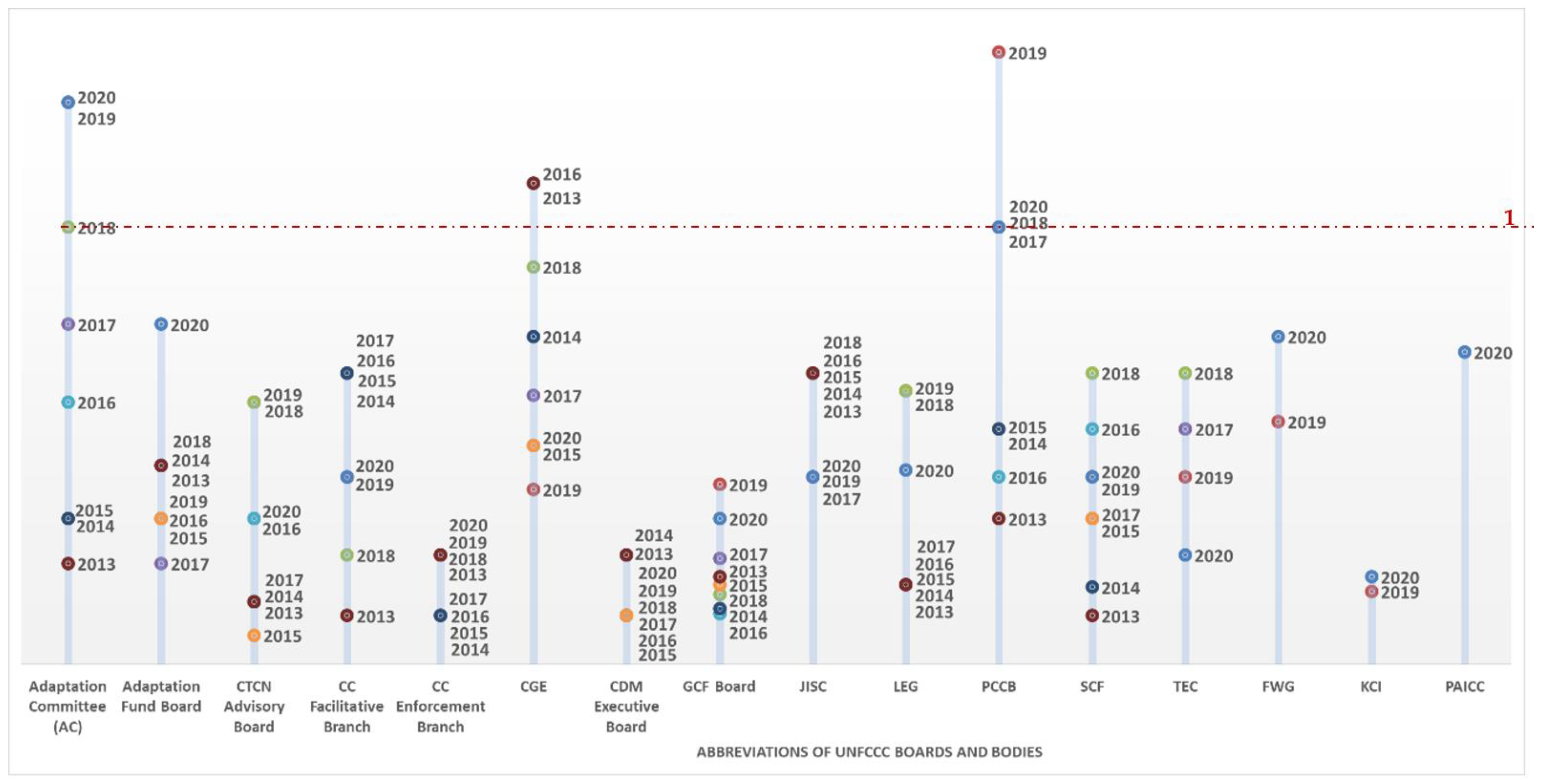
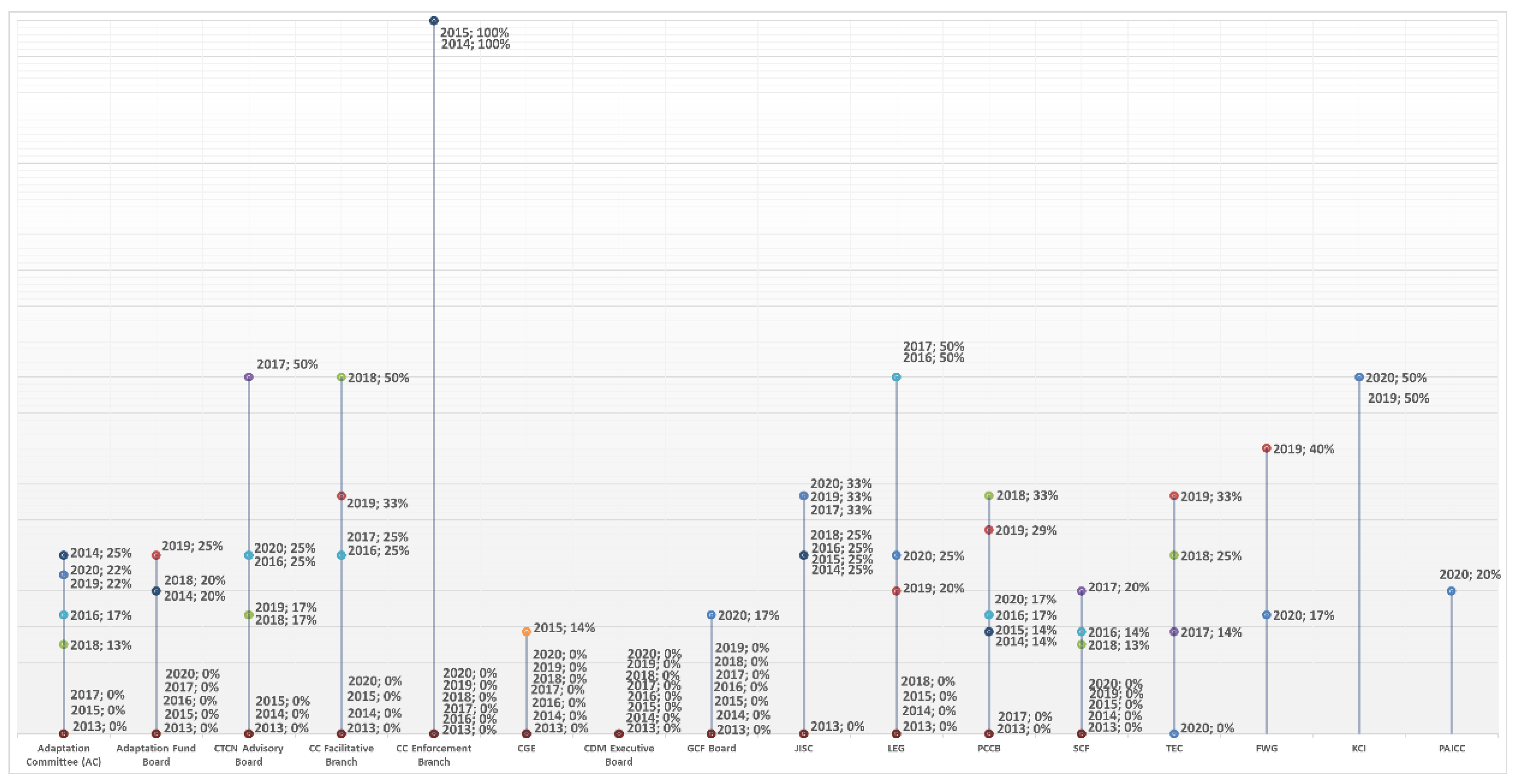
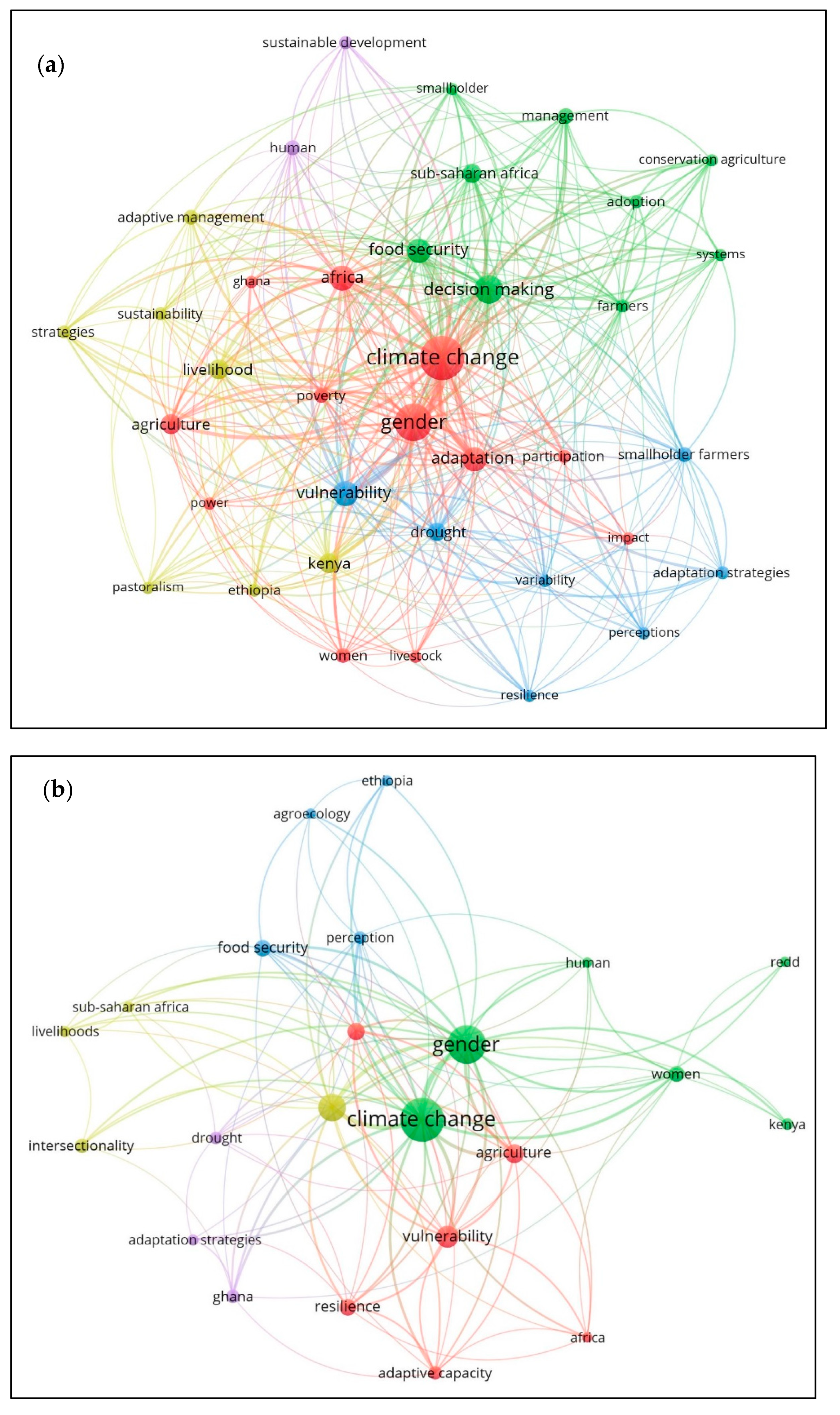
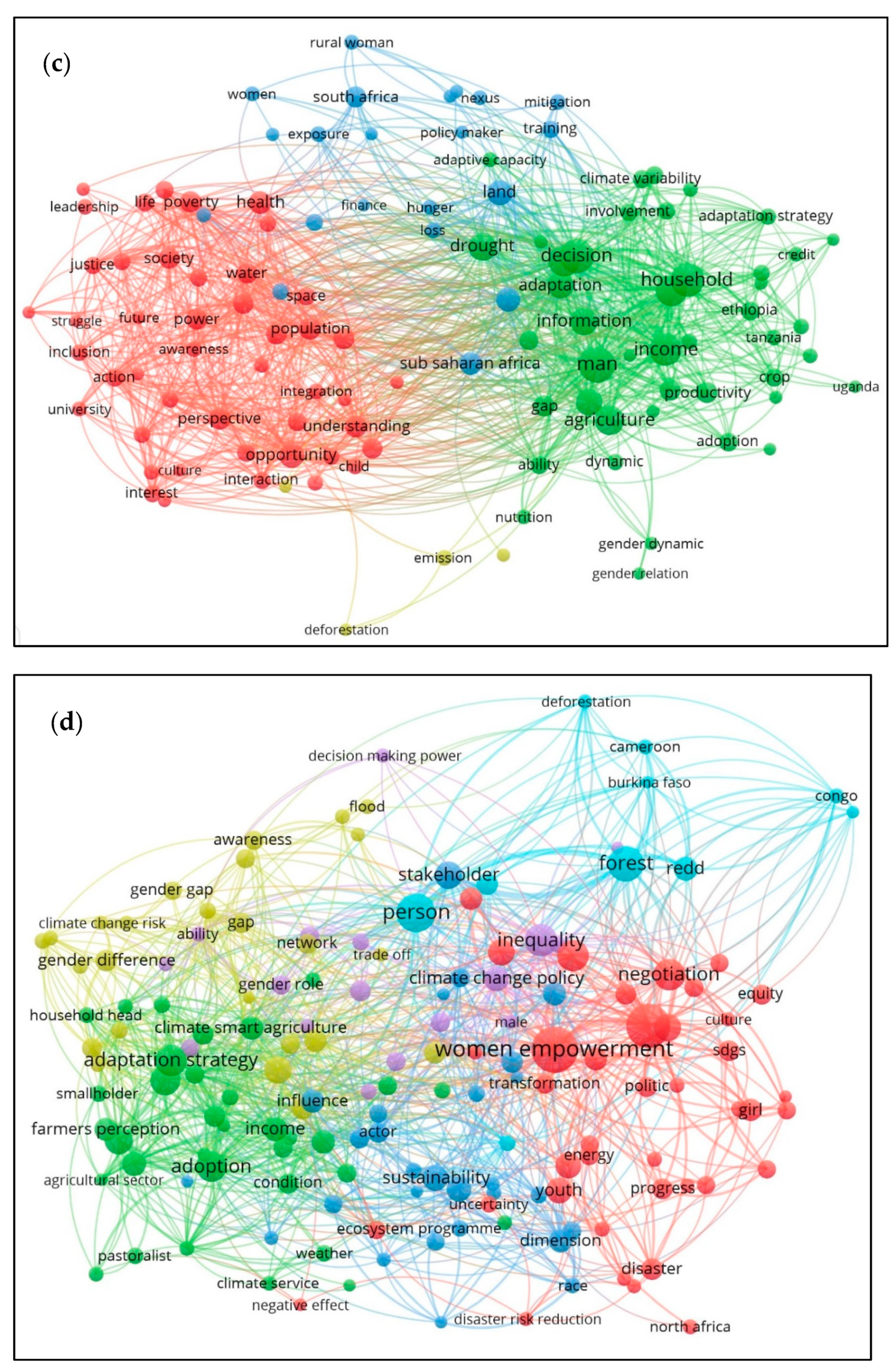
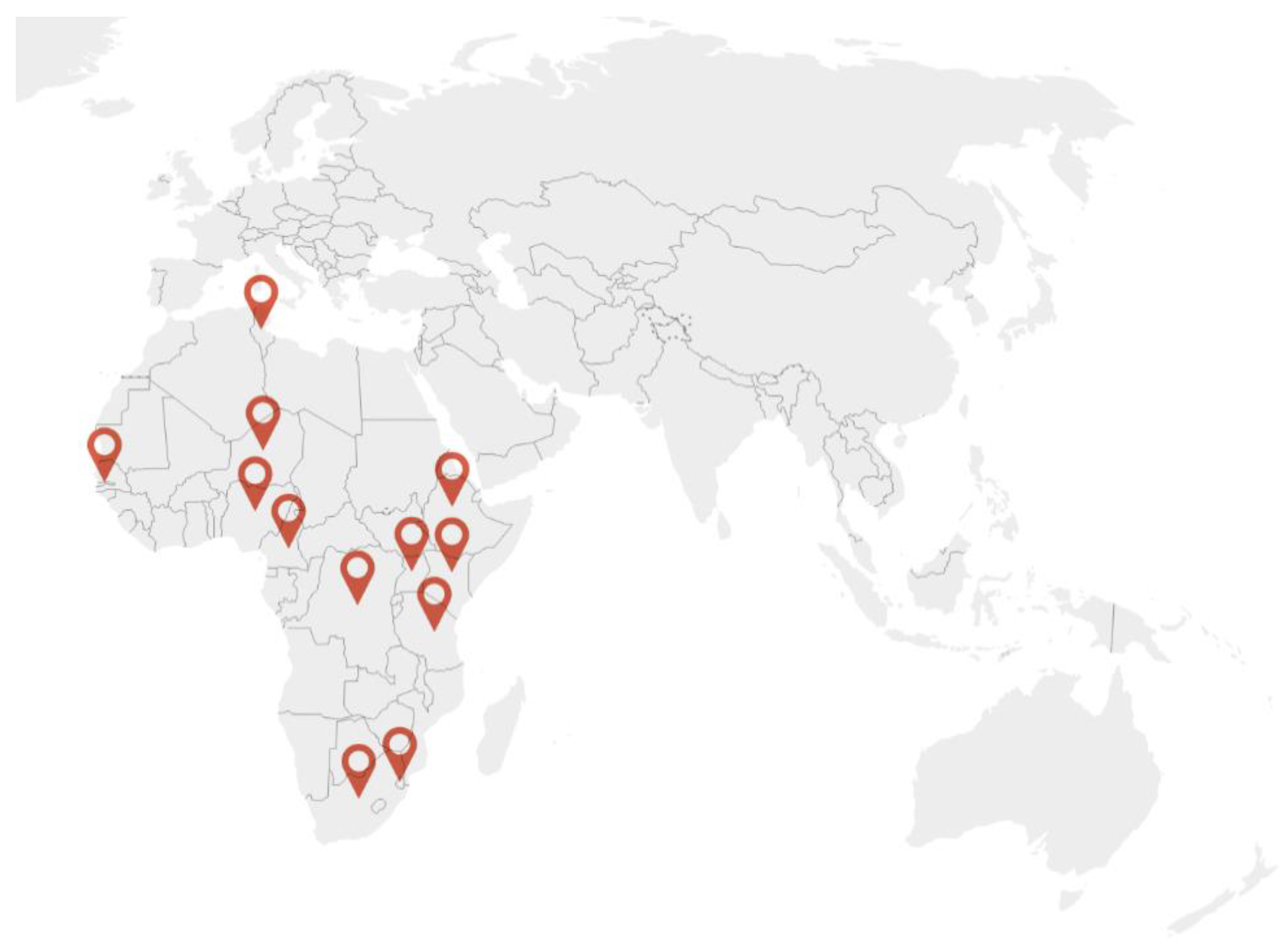
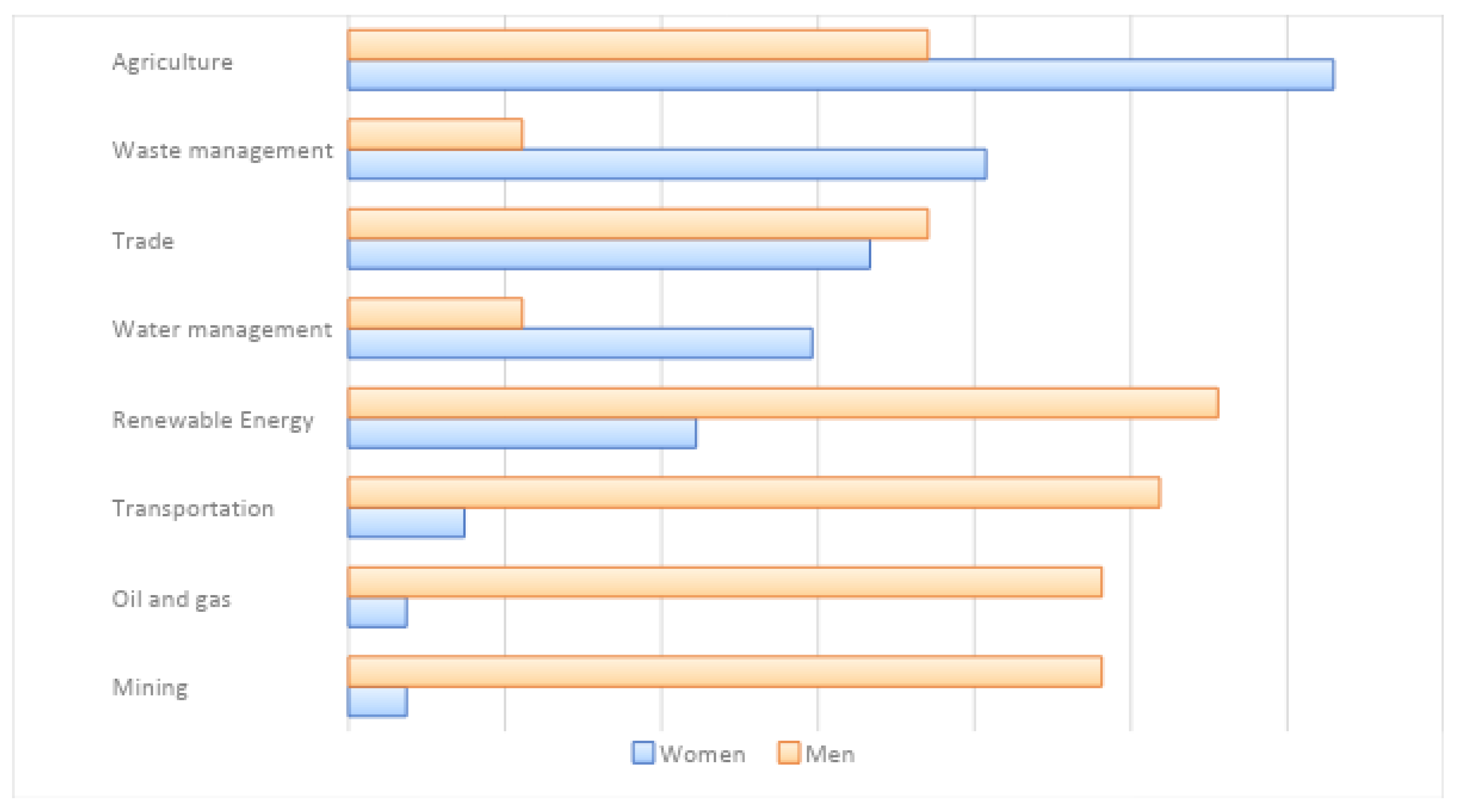
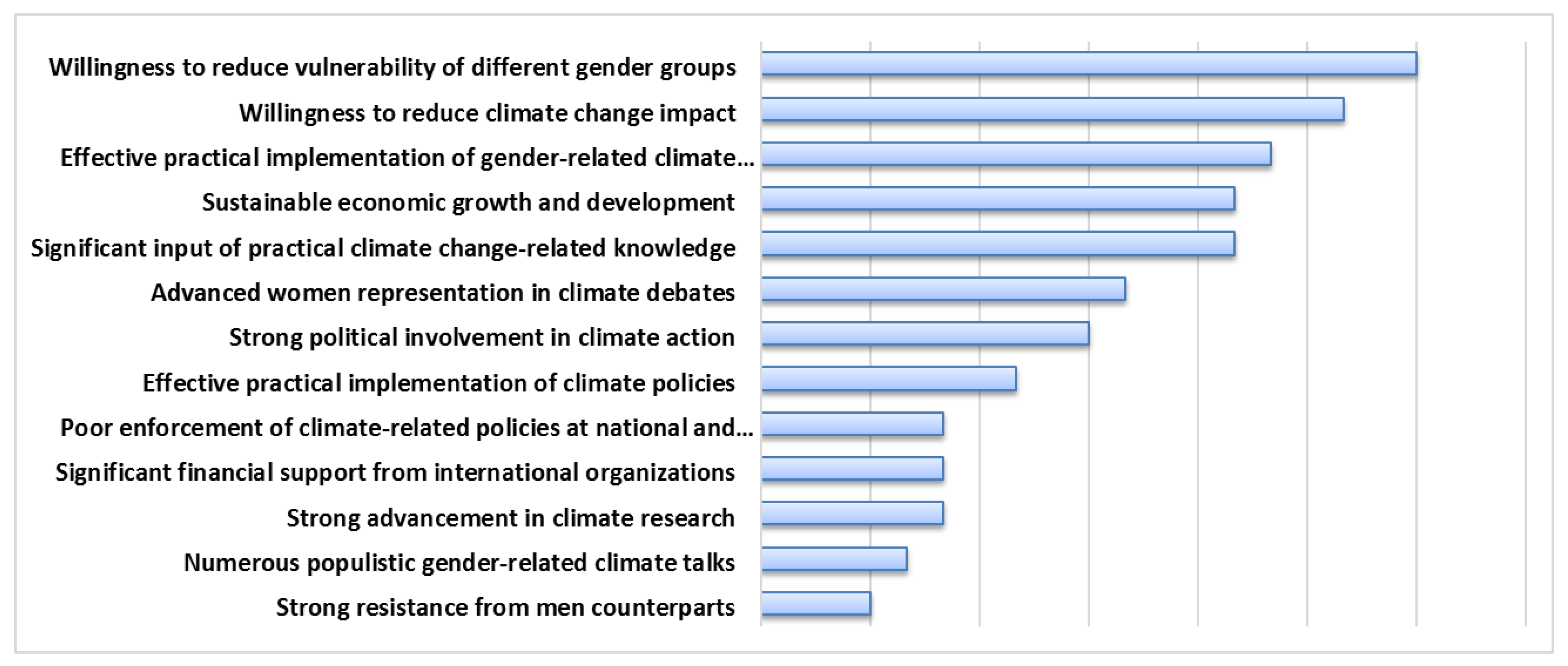
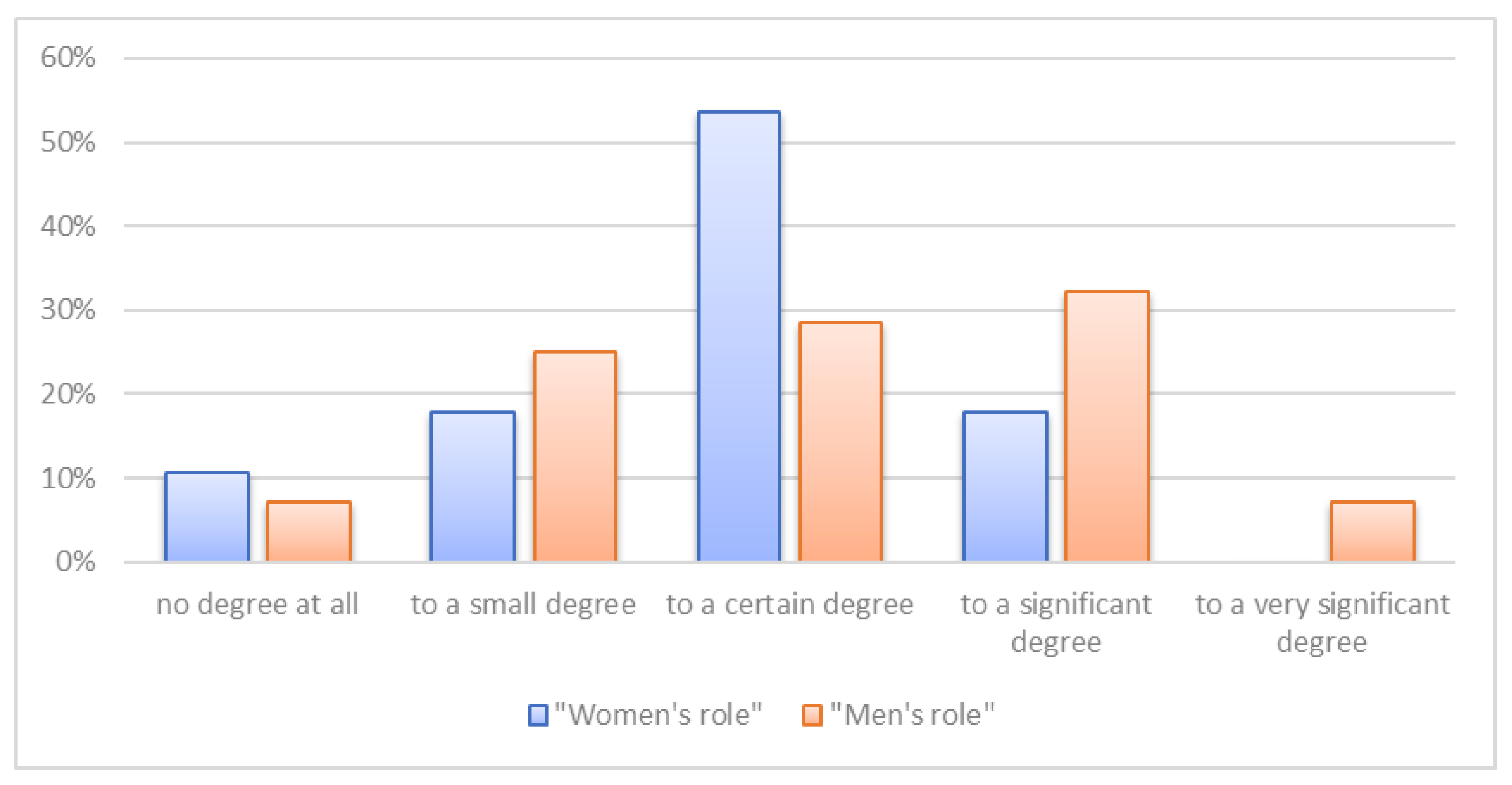
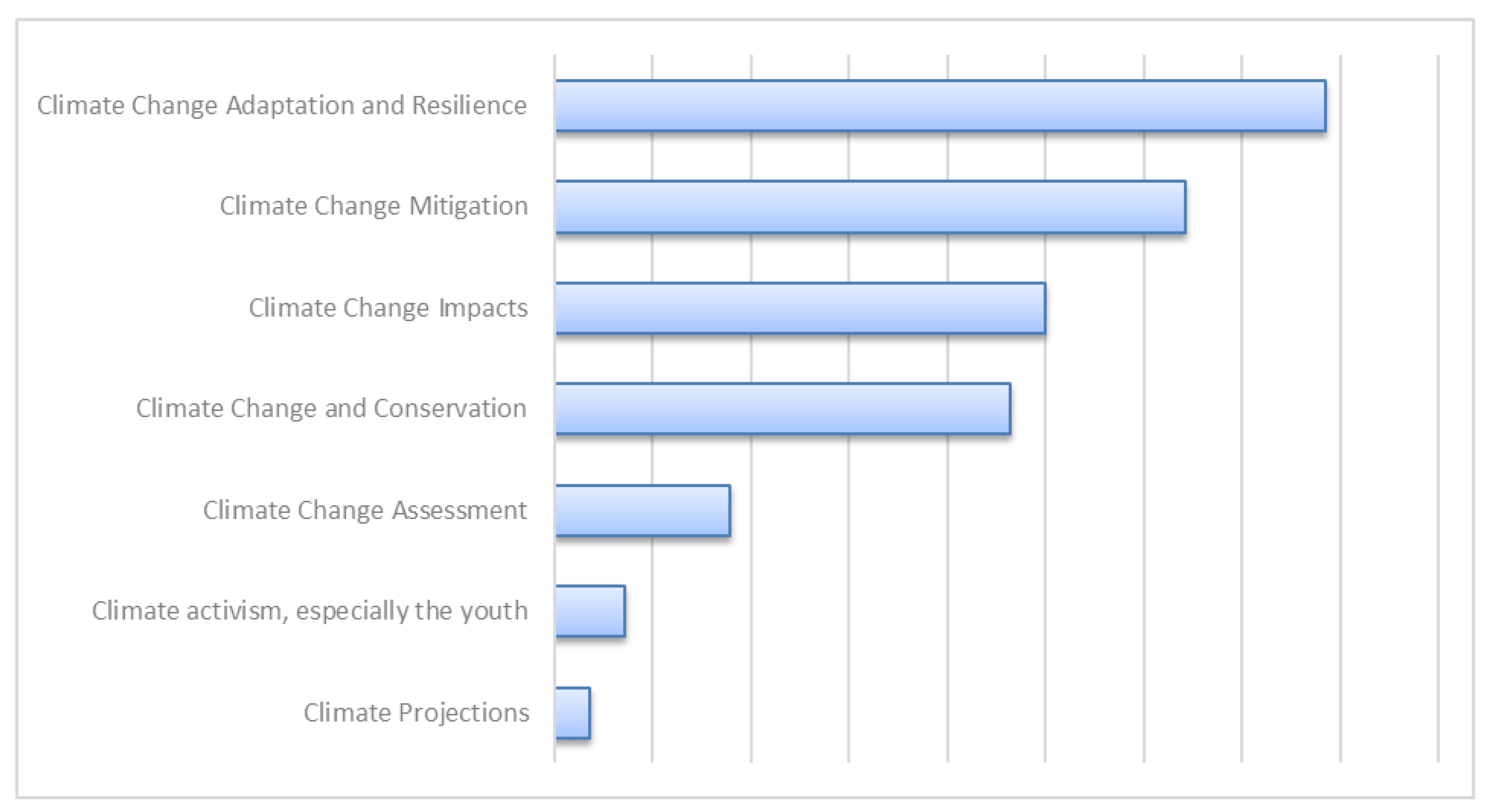
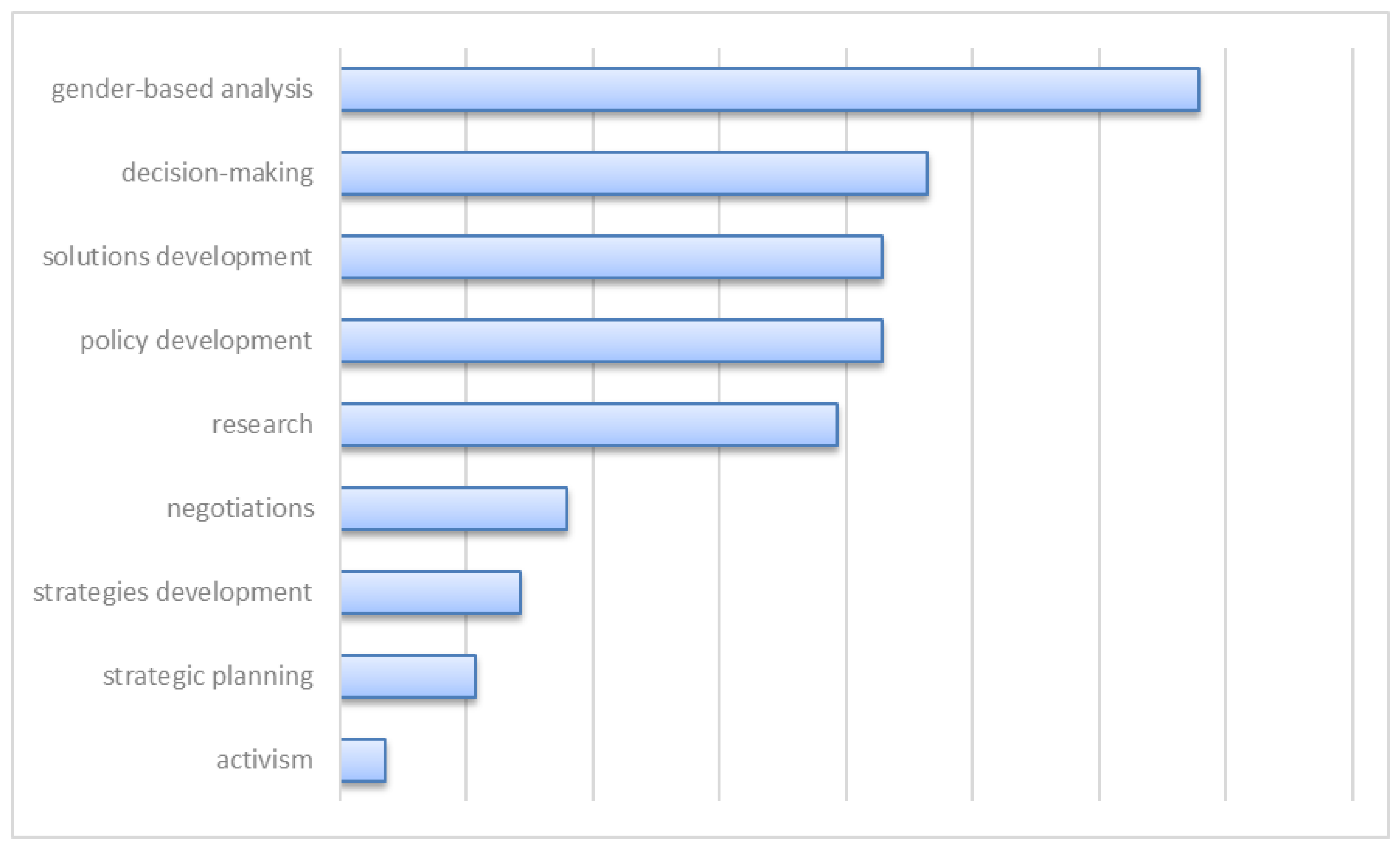
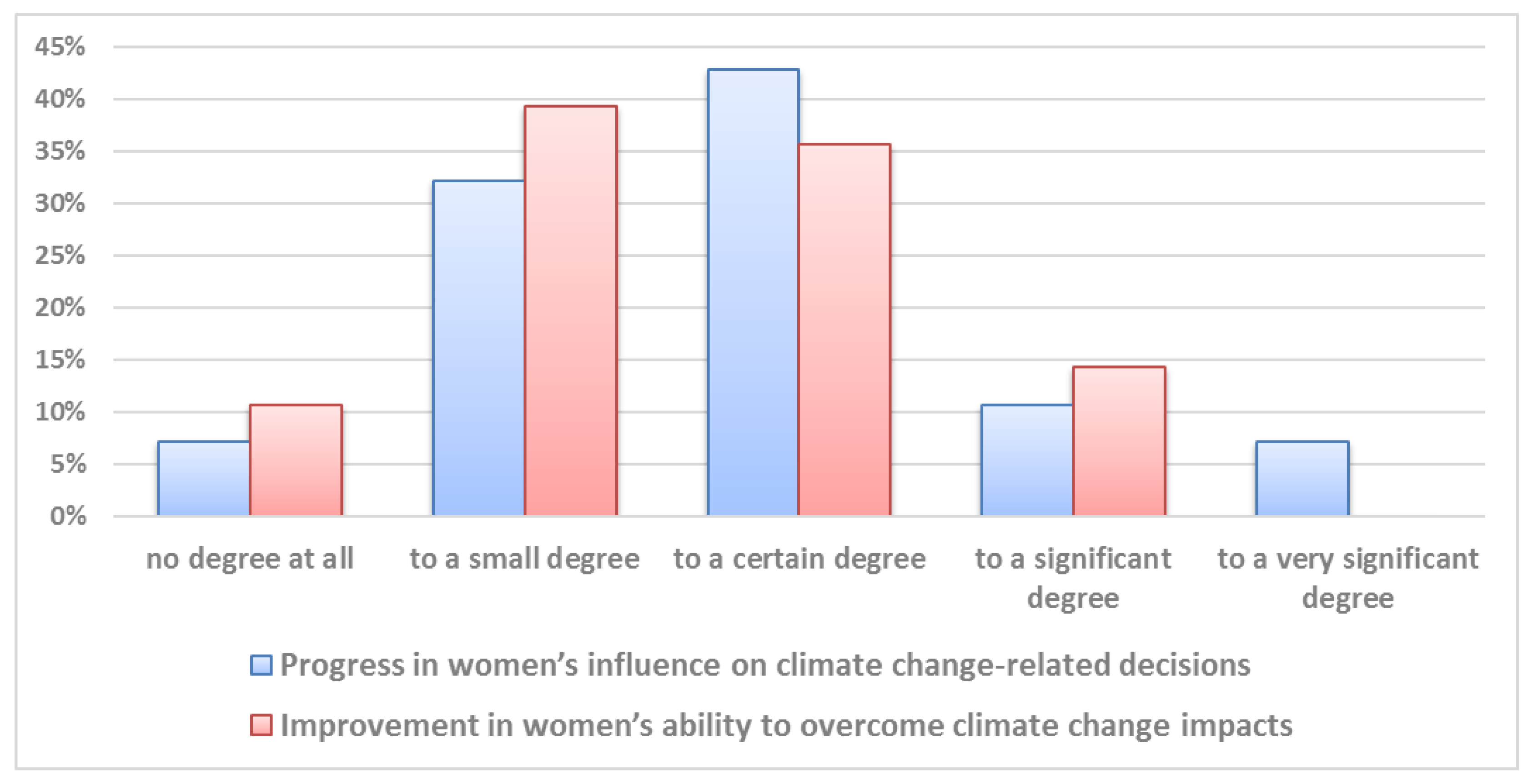
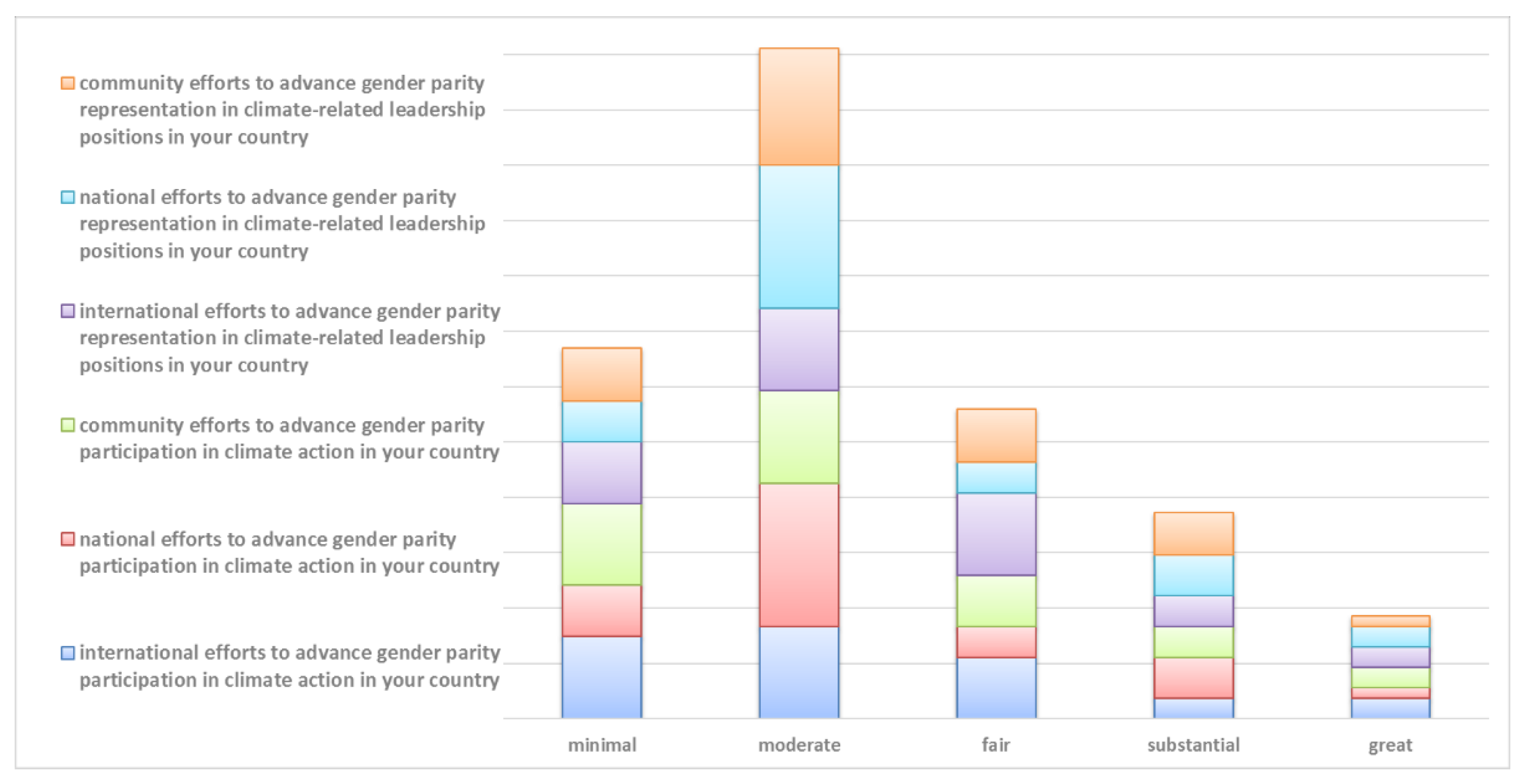
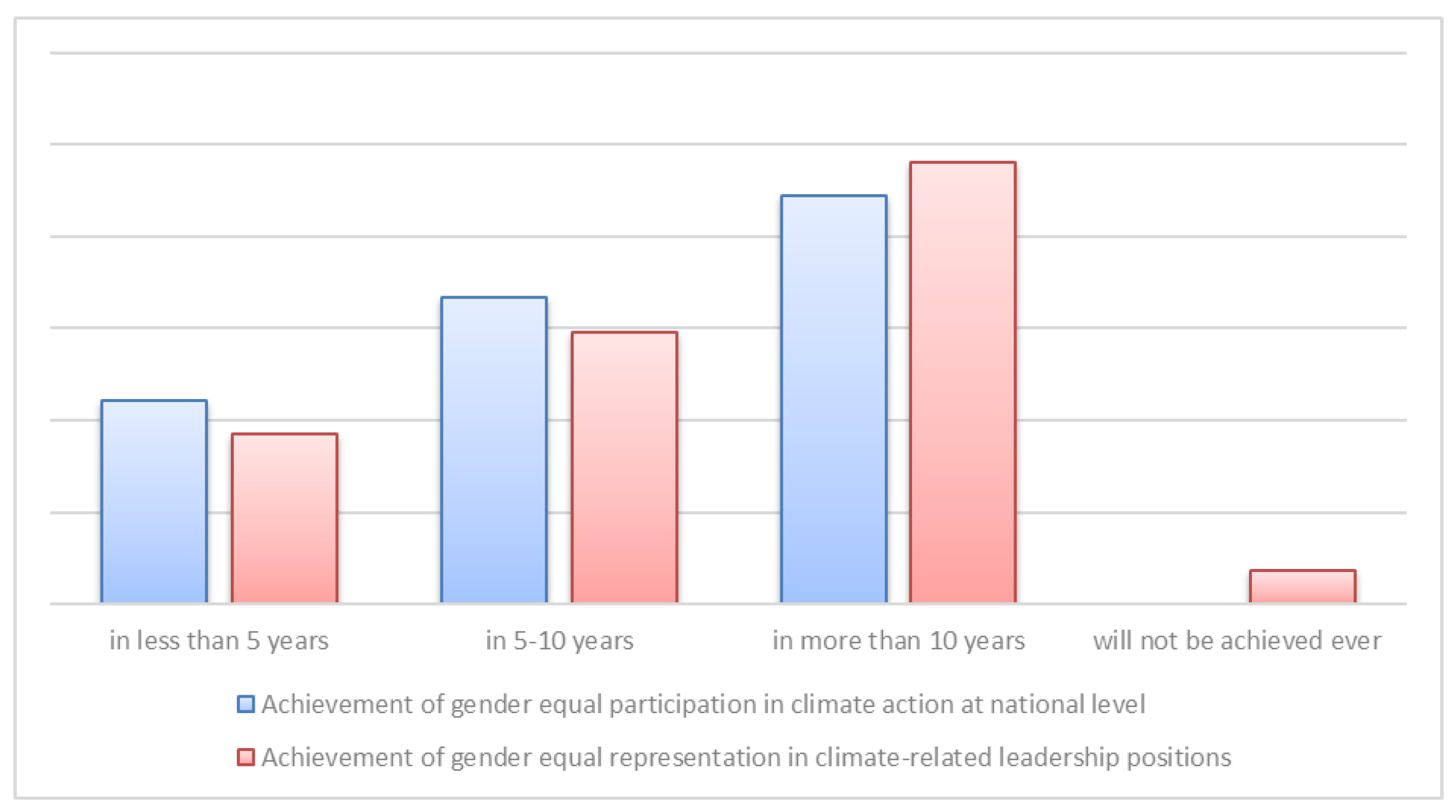

| Domains | Interconnections (Selected) | Description | Reference |
|---|---|---|---|
| Vulnerability | Natural disasters and extreme weather events | Natural disasters: extreme weather events and their subsequent impacts might disproportionately affect different gender groups, increasing existing inequalities, and undermining their water and food security. The events also narrow the gender gap in life expectancy. | [5,47,48,49,50,51] |
| Climate change-induced displacement/migration | Climate-induced displacement is caused by an individual’s inability to adapt to the environmental and the socio-economic consequences of climate change as a result of inequalities or a lack of resources. It is triggered by direct physical harm from extreme weather events or slow-onset impacts, indirect consequences on food insecurity and conflict over natural resources and land rights. Women represent more than half of displaced people. Very often, they face an increased risk of domestic or sexual violence and deterioration in their physical, emotional and mental health, and have less access to relief resources. | [52,53,54] | |
| Unequal adaptive capacities | Gender groups have unequal adaptive capacities due to a lack of or limited decision-making powers, assigned roles and tasks, labour division, gender-biased legislation, limited access to and availability of technology, economic capital and productive resources, and gaps in literacy level, health and nutritional status. | [5,17,50,51] | |
| Limited or no access to information, education, knowledge | Gender inequalities in access to education and information are among the key causes of vulnerability to climate change that decrease an individual’s ability to build up resilience to its impacts. | [18,19,20] | |
| Limited or no access to resources (e.g., natural, financial, etc.), ownership rights | Socio-cultural gender roles and norms that determine access to resources and (land) ownership rights influence and shape an individual’s vulnerability. Very often, women have limited or no access/rights. | [17,18,55,56] | |
| Gender-blind climate finance/policies/interventions | Gender-blind climate finance might reinforce climate change vulnerabilities. Very often, funding institutions lack a gender perspective in their policy frameworks. Prior to 2015, projects that address climate change and women’s rights received 0.01% of worldwide funding support. The efficacy and effectiveness of mitigation and adaptation interventions might be significantly reduced due to the exclusion of gender issues from climate-related projects and policies, although, in recent years, the situation has been changing. | [24,25,57,58] | |
| Benefits | Agents of change | Women are powerful agents of change to address climate change at scale. | [24,26] |
| Gendered-balanced participation and engagement | Women’s increased participation in decision-making processes at various levels of governance makes considerable contributions to natural resource management, biodiversity conservation efforts, ratification of international environmental treaties, building community resilience and responding to climate-related disasters. Their expertise and experience contribute to the reduction in adverse impacts and accelerate the development of technological innovations to address climate change. | [19,24,59,60] | |
| Climate resilience and adaptive capacity | A reduction of gender imbalances is one of the most effective mechanisms in the development of climate resilience and adaptive capacity, which, in turn, improves food security. | [26,33,61] | |
| Paris Agreement | Support of gender equality and women’s rights is one of the most powerful ways to implement the Paris Agreement. | [26] | |
| Leadership/Empowerment | Equal representation on boards/administrative and political bodies | Equal gender representation in administrative and political bodies engaged in climate change contributes to effective climate change policies. However, sometimes, having a critical number of women on these bodies does not directly lead to the development of gender-sensitive climate change policies and/or the inclusion of gender differences in climate issues. | [60,62] |
| Underrepresentation | There is a gender gap in representation (women are underrepresented) in climate-change-related decision-making processes in climate governance, including in international delegations on UNFCCC bodies. | [42,63] | |
| Adaptation strategies and decision-making | Adaptation capacities to climate change are positively influenced by women’s empowerment and decision-making power. | [45,46] |
| Criteria | Description |
|---|---|
| Data range | 2015–2022 |
| Language | English |
| Type of publication | All types available in the collections |
| Databases | Scopus, Web of Science, Google Scholar |
| Geographical focus | Selected African countries |
| Strongly Agree | Agree | Neutral | Disagree | Strongly Disagree | |
|---|---|---|---|---|---|
| Lack of women’s leadership ambitions |  |  |  |  |  |
| Lack of women’s confidence in their ability to participate |  |  |  |  |  |
| Lack of knowledge and expertise |  |  |  |  |  |
| Lack of social and professional experience |  |  |  |  |  |
| Lack of accumulated career capital |  |  |  |  |  |
| Lack of qualities and skills |  |  |  |  |  |
| Lack of political will in the country despite international gender equality commitments |  |  |  |  |  |
| Women’s negative attitude towards leadership activities |  |  |  |  |  |
| Low socio-economic status of women |  |  |  |  |  |
| Lack of role models of women leaders |  |  |  |  |  |
| Lack of the networks and contacts |  |  |  |  |  |
| Strongly Agree | Agree | Neutral | Disagree | Strongly Disagree | |
|---|---|---|---|---|---|
| A change in women’s role in climate action over the last five years, if any, has led to positive outcomes |  |  |  |  |  |
| A change in men’s role in climate action over the last five years, if any, has led to positive outcomes |  |  |  |  |  |
| A change in women’s role in climate action over the last five years, if any, has led to negative outcomes |  |  |  |  |  |
| A change in men’s role in climate action over the last five years, if any, has led to negative outcomes |  |  |  |  |  |
Publisher’s Note: MDPI stays neutral with regard to jurisdictional claims in published maps and institutional affiliations. |
© 2022 by the authors. Licensee MDPI, Basel, Switzerland. This article is an open access article distributed under the terms and conditions of the Creative Commons Attribution (CC BY) license (https://creativecommons.org/licenses/by/4.0/).
Share and Cite
Kovaleva, M.; Leal Filho, W.; Borgemeister, C.; Kalungu, J.W. Understanding Needs and Potentials for Gender-Balanced Empowerment and Leadership in Climate Change Adaptation and Mitigation in Africa. Sustainability 2022, 14, 9410. https://doi.org/10.3390/su14159410
Kovaleva M, Leal Filho W, Borgemeister C, Kalungu JW. Understanding Needs and Potentials for Gender-Balanced Empowerment and Leadership in Climate Change Adaptation and Mitigation in Africa. Sustainability. 2022; 14(15):9410. https://doi.org/10.3390/su14159410
Chicago/Turabian StyleKovaleva, Marina, Walter Leal Filho, Christian Borgemeister, and Jokastah Wanzuu Kalungu. 2022. "Understanding Needs and Potentials for Gender-Balanced Empowerment and Leadership in Climate Change Adaptation and Mitigation in Africa" Sustainability 14, no. 15: 9410. https://doi.org/10.3390/su14159410







